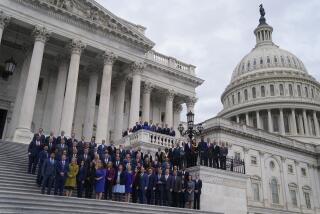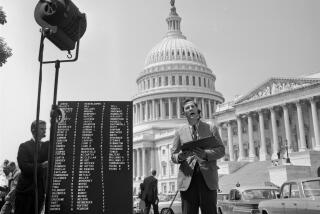A Patriot Abroad
- Share via
The Statue of Liberty, meticulously patched and fitted with a new flame, turns 100 this week. Through the years, the statue has been transformed from a symbol of fraternity between France and the United States into the pre-eminent symbol of freedom, a beacon for millions of immigrants and a patriotic symbol of unrivaled emotional intensity. It has inspired poetry and song, speechmaking and caricature. But mostly the statue has been a personal symbol, to millions around the world, of the hopes and promise of a nation that proclaims itself dedicated to individual liberty. Five very personal perspectives:
William Wharton is the pseudonym of an expatriate American writer who has lived in Paris for more than a quarter-century. Author of the novels “Birdy” and “Dad,” he is also a well-known painter. He provided a fictionalized account of his life as an artist in France in his 1984 book, “Scumbler.”
Because I am an American who lives a good part of the year by choice in Paris, the Statue of Liberty means much to me.
There is, in the Jardin du Luxembourg, on the left bank of the Seine, a small model of this statue, built by the French from public donations and representing the high regard France has long had for the American experiment with democracy. They feel involved because many of the ideas we cherish as part of our way of life evolved from French thinkers.
I’ve often taken my children to this statue and talked about what it means, both as a symbol for the French and as a symbol to them.
There is another copy, somewhat larger, but still small in relation to the original. It is on a bridge as one comes in from the west of Paris. It looks out over the Seine and seems appropriate, staring with its air of contentment and strength over the water.
Each time I pass it, I remember the first time I saw the original. We were on our way back to America after having just finished with the war in Europe. We’d left the port of Le Havre on the Fourth of July, and for many of us it was a sort of liberation, liberation from constant fear and misery.
We came across on the America, a passenger ship adapted to troop transport. I don’t know how many thousands of us were crammed into the ship. I know that eight of us were stacked in a room designed for two.
On our ship, and separated from us, was a motley crew of foreign-looking men who took the air on the front deck. They wore the overcoats and fedoras of the times. They always seemed to have something to say to each other and gesticulated more than any of us would. I now realize that these were some of the men being brought to America as part of the “massive brain import” that led to the development of rocketry.
It was early morning when we pulled into New York Harbor. I’d never seen the Statue of Liberty. We’d left for Europe a year ago in the dark of night, on the Queen Elizabeth, equally crowded, and dashed across the ocean to a port in Scotland in less than five days. The theory was that by going so fast we could outrun submarines. Fortunately, the theory proved itself this time.
There weren’t many of us up on deck that morning as we came into New York Harbor. It was 6 o’clock in the morning. I stood at the rail and watched as the lovely lady of liberty gradually appeared in the mists hanging over the river. I didn’t expect I would be so deeply moved. I was only 19 years old.
I knew we were to be given a 30-day furlough, then sent to fight the Japanese in yet another war. It was the war that we in Europe had dreaded. We had felt blessed to fight in forests and fields instead of on beaches and in jungles.
I looked down as the light came up and saw that the deck below me was crowded with the men in overcoats. There was no sound from them, but they were stiff and still in rapt attention.
I’ve often wondered what they were thinking. In a way, they were like slaves on a slave ship, unwillingly being transported to a new land to be worked. In another way they must have felt their enormous luck to be going this way instead of the other, or being left instead in the rubble of their homes.
Near our apartment in Paris is the foundry where the statue was cast in pieces for transport to America and for final assembly. It was a magnificent piece of engineering and art in unison. I’ve taken my children there several times as well, and twice visited it myself so I could explore the place privately.
Most people think of the Statue of Liberty in terms of immigration to America, as a symbol to all who suffer in their own lands and want a new chance. To me it means more than that. It means the right of Americans to live wherever they want, without punishment or determent. It truly represents liberty.
I imagine that most people would have to consider me an expatriate. I left America for reasons having nothing to do with politics, religion, economic repression. Oddly enough, I left to take my children away from the invasion of television and to keep them closer to our family identity. The peer pressures, drugs, cigarettes, alcohol consumption of the young worried me. I was a teacher and didn’t want it for my children.
Also, as an artist, I felt that the development of art in America was unrelated to the directions I wanted to go. I wanted the psychic elbow room to develop in my own personal way.
Many people confuse the words expatriate and ex-patriot . I am a patriot. I love America. My wife and children love America. We are proud of our heritage. I am expatriate in that there are movements, ways of life evolving in my native land, in which I do not wish to participate. I am not a politician. I am a painter and writer. I try to paint and write my feelings about what life should be. I try to communicate these feelings to my countrymen. It is my small way to thank our country for all it has given me.
More to Read
Sign up for our Book Club newsletter
Get the latest news, events and more from the Los Angeles Times Book Club, and help us get L.A. reading and talking.
You may occasionally receive promotional content from the Los Angeles Times.









